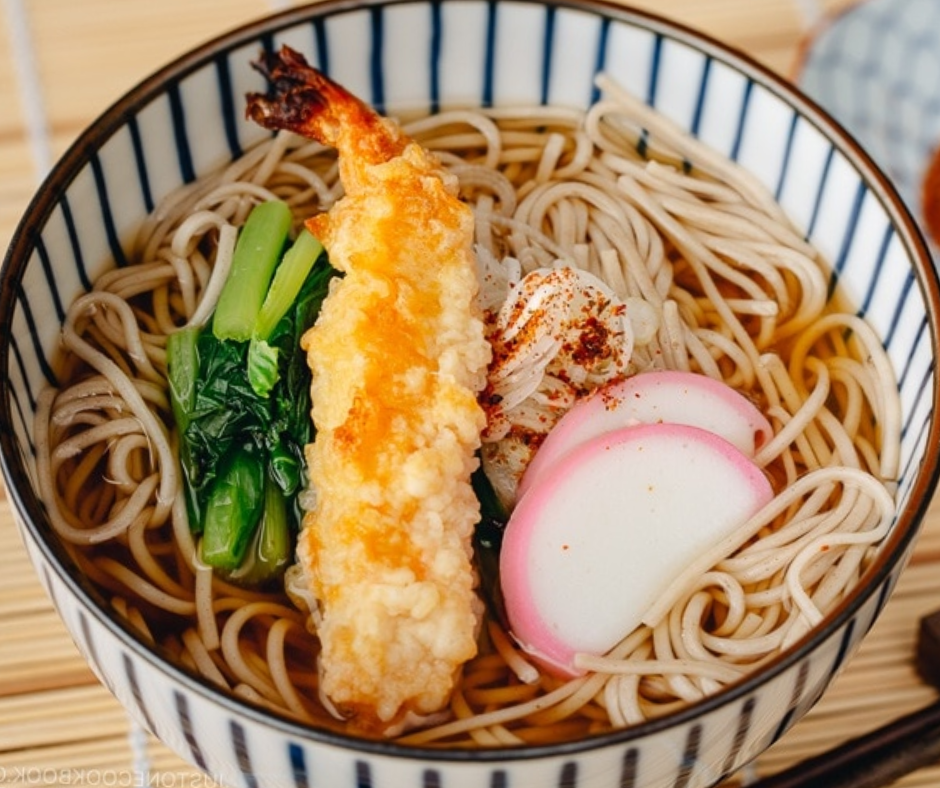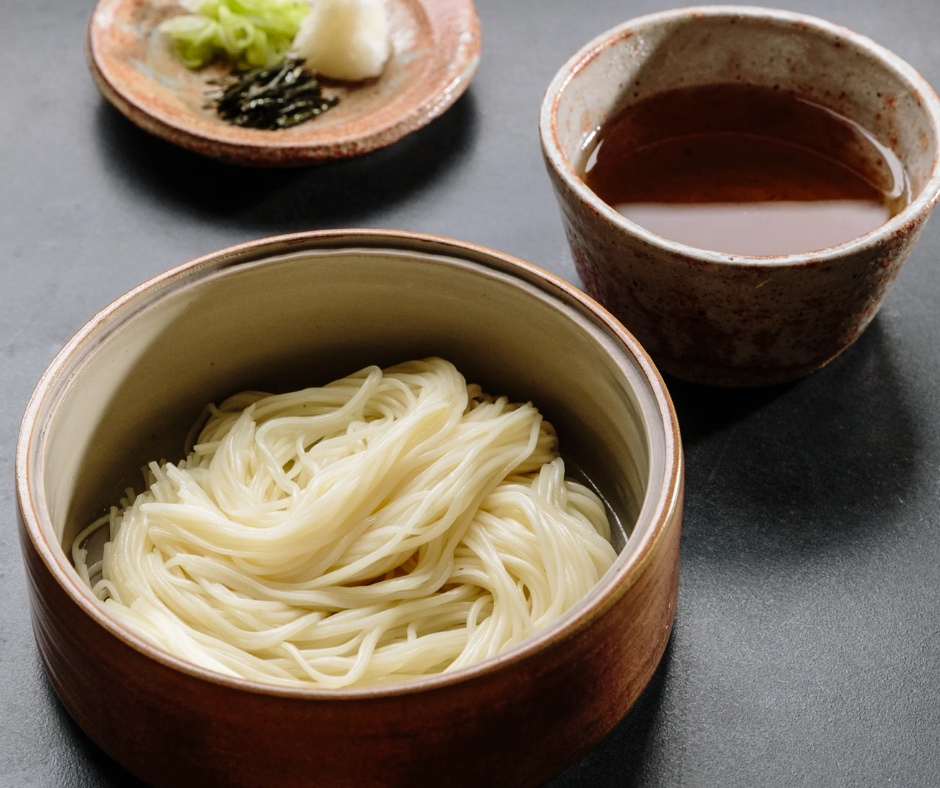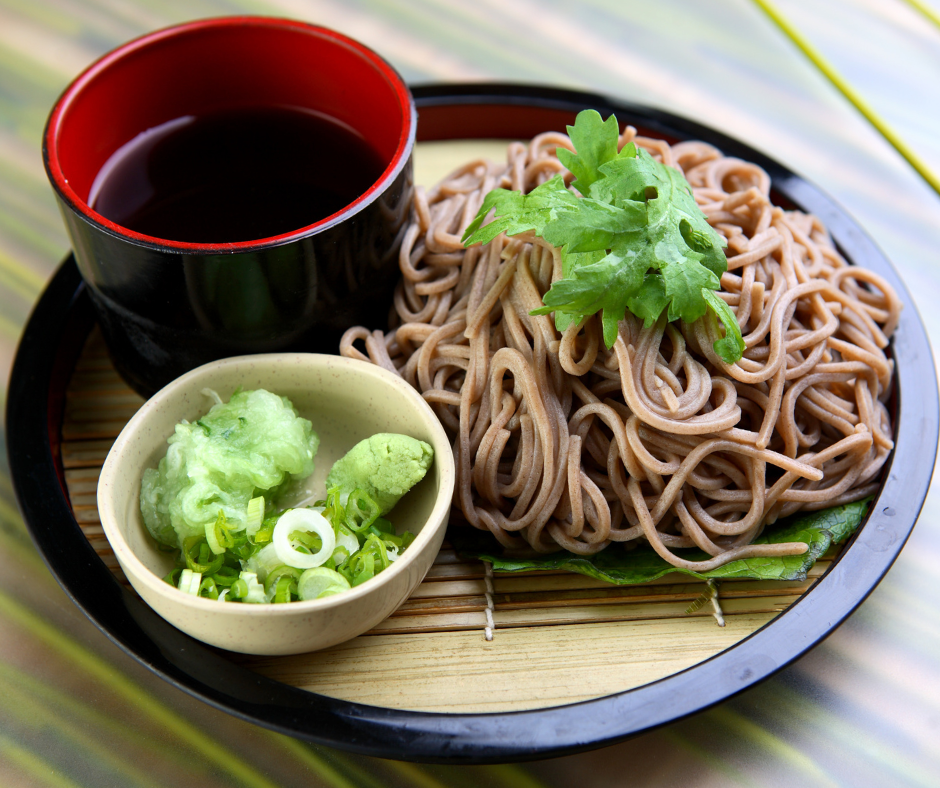Introduction
Regarding Japanese cuisine and noodles, Somen and Soba are two popular varieties, often in a delicious showdown. Both noodles have their unique characteristics and flavors that make them stand out. In this article, we’ll dive into the world of Somen and Soba, exploring the comparison of Somen vs Soba and which might suit your taste buds better.
What Are Somen And Soba Noodles?
Somen noodles are thin, white noodles made from wheat flour and salt. They are typically served cold, especially during the hot summer months in Japan. Somen noodles are often enjoyed with a dipping sauce or in a light broth and are known for their delicate and slippery texture.
On the other hand, Soba noodles are made from buckwheat flour mixed with wheat flour, giving them a slightly nutty flavor. Soba noodles can be enjoyed both hot and cold, making them versatile for various dishes. They are commonly served in a soy-based broth or as a stir-fry and are favored for their slightly chewy texture.
Key Differences Between Somen And Soba Noodles
Ingredients: The ingredients are the main difference when comparing Somen vs Soba. Somen noodles are made purely from wheat flour, while Soba noodles contain a mixture of buckwheat and wheat flour. This distinction gives each noodle its unique taste and texture.
Preparation: Somen noodles are typically served cold and are often enjoyed with a dipping sauce, while Soba noodles can be served hot or cold, depending on the dish. Additionally, Soba noodles are often used in stir-fry dishes and can be enjoyed with various toppings such as tempura or green onions.
Texture: Somen noodles are smooth and slippery, making them easy to slurp. On the other hand, Soba noodles have a slightly chewy texture that adds a satisfying bite to each mouthful.
Flavor: While both noodles have distinct flavors, Soba noodles have a slightly nutty taste due to the buckwheat flour. On the other hand, Somen noodles have a more neutral flavor that pairs well with different dipping sauces and broths.
Health Benefits: Soba noodles are often considered the healthier choice due to their higher fiber content and lower calorie count than Somen noodles. Buckwheat is also a good source of various minerals and antioxidants.
In conclusion, Somen and Soba noodles are beloved staples in Japanese cuisine, each with unique characteristics and flavors. Whether you prefer the delicate and slippery texture of Somen or the slightly chewy and nutty flavor of soba, both noodles offer a delicious and satisfying dining experience. So go ahead, try them, and discover which Japanese noodle is your favorite!
Somen Noodles
Characteristics And Flavor Profile Of Somen Noodles
Somen noodles are a type of Japanese noodle that are thin and delicate. They are made from wheat flour, water, and sometimes eggs. Somen noodles are extremely thin, similar to angel hair pasta, and have a delicate, soft, and chewy texture.
Somen noodles are mild in terms of flavor and have a subtle wheat taste. This makes them versatile and suitable for a wide range of dishes. They can be served hot or cold and are often used in soups, stir-fries, and salads. Somen noodles are also known for absorbing flavors, making them a great choice for dishes with bold and savory sauces.
Popular Dishes Made With Somen Noodles
Somen noodles can be found in various traditional Japanese dishes and modern interpretations. Here are some popular dishes made with Somen noodles:
- Hiyashi Chuka: Hiyashi Chuka is a refreshing cold noodle dish perfect for hot summer days. It typically consists of chilled Somen noodles with colorful vegetables, ham, egg, and a tangy sesame dressing.
- Somen Salad: Somen salad is a simple and healthy dish that combines cold Somen noodles with crisp vegetables. It is often dressed with a light soy-based dressing and garnished with sesame seeds.
- Somen Soup: Somen noodles can also be enjoyed in a warm and comforting soup. The noodles are added to a flavorful broth and toppings such as sliced green onions, kamaboko (fish cake), and tempura.
- Tori Somen: Tori Somen is a popular summer dish that features Somen noodles served in a savory chicken broth. It is often garnished with shredded chicken, green onions, and grated ginger for added flavor.
- Tempura Somen: Somen noodles can be deep-fried to create a delicious, crispy dish. The fried noodles are served with a dipping sauce and topped with tempura, such as shrimp or vegetables.
- Somen with Mentsuyu: Mentsuyu is a soy-based dipping sauce commonly used in Japanese cuisine. Somen noodles can be served with mentsuyu as a dipping sauce, allowing you to enjoy the noodles with a burst of umami flavor.
Somen noodles offer a light and satisfying eating experience, whether in a cold dish or a hot soup. Their delicate texture and mild flavor make them versatile for various dishes. So whether you’re a noodle enthusiast or just looking to explore Japanese cuisine, be sure to try Somen noodles!
Soba Noodles
Characteristics And Flavor Profile Of Soba Noodles
Soba noodles are thin and long, made from wheat and buckwheat flour. This distinctive blend gives Soba noodles a slightly nutty flavor and a chewy texture that many love. The buckwheat flour used in making Soba noodles also gives them a darker color than other wheat noodles.
One of the defining characteristics of Soba noodles is their versatility. They can be enjoyed hot and cold, making them perfect for year-round consumption. Hot soba is commonly served in a flavorful broth, often with toppings like green onions, tempura, or sliced meats. On the other hand, Cold Soba is served chilled with dipping sauces like tsuyu or soy sauce mixed with wasabi for added zing. The dipping sauces complement the nutty flavors of the Soba noodles perfectly.
Popular Dishes Made With Soba Noodles
Soba noodles are a staple in many traditional Japanese dishes. Here are a few popular ones:
- Zaru Soba: This is a classic cold Soba dish. The noodles are served on a bamboo mat with a dipping sauce made from soy sauce, mirin, and dashi. It is commonly garnished with grated daikon radish and nori seaweed.
- Tempura Soba: A delightful combination of crispy tempura and hot Soba noodles served in a flavorful broth. The tempura adds a crunchy texture and enhances the dish’s overall taste.
- Kake Soba: Simple yet satisfying, Kake Soba consists of hot Soba noodles in a warm broth made from soy sauce, mirin, and dashi. It is often topped with green onions and tempura flakes.
- Tororo Soba: A unique dish with grated yam (Tororo) mixed with cold Soba noodles, creating a creamy and refreshing flavor. It is typically served cold with a dipping sauce.
Whether you prefer hot or cold, Soba noodles offer various flavors and options to suit every taste. Their versatility and unique characteristics make them a beloved choice among Japanese noodle enthusiasts.
So, whether you’re craving a hot and comforting bowl of soba in the winter or a refreshing cold Soba dish on a hot summer day, you can always count on Soba noodles to satisfy your cravings with their unique flavors andures.
Somen and soba are both popular types of Japanese noodles, each with its unique characteristics and flavors. In this showdown, we will explore the key differences between somen and soba to help you decide which is right for your next meal.
Somen Vs Soba: Japanese Noodle Showdown
Regarding Japanese noodles, Somen and Soba are two popular varieties that have captured the hearts and taste buds of food lovers worldwide. While both noodles are made from wheat flour, they have distinct characteristics and flavors that set them apart. Let’s compare Somen vs Soba and discover what makes each unique.
Texture Comparison: Thinness Of Somen Vs. Nuttiness Of Soba
One of the main differences you can see when comparing Somen vs Soba is their texture. Somen noodles are extremely thin, delicate, and smooth. They have a light and tender texture that almost melts in your mouth. On the other hand, soba noodles have a more robust texture with a slightly rougher surface. Soba noodles are made from buckwheat flour, which gives them a nutty flavor that pairs well with various toppings and dipping sauces. The nuttiness of soba noodles adds another layer of complexity to the overall dining experience.
Cooking Methods And Serving Styles
Somen and soba noodles are prepared and served differently. Somen noodles are typically served cold and commonly enjoyed during hot summer. They are boiled, rinsed with cold water, and then served with a dipping sauce called tsuyu. The chilled noodles provide a refreshing, light meal option, perfect for beating the heat.
On the other hand, soba noodles are usually served both hot and cold, offering versatility in various dishes. They can be enjoyed in a warm broth, similar to ramen, or cold with a dipping sauce. This flexibility makes soba noodles suitable for year-round consumption.
Regarding cooking time, some noodles cook quickly and are ready to serve in just a few minutes. On the other hand, Soba noodles require a slightly longer cooking time due to their thicker texture and buckwheat composition. However, both noodles are relatively easy to prepare, making them accessible options for home-cooked meals.
To summarize, when comparing Somen vs Soba, both have distinct characteristics and serving styles. Somen noodles are thin, delicate, and perfect for cold summer dishes, while soba noodles have a nuttier flavor and can be enjoyed in various ways, both hot and cold. Whichever noodle you choose, you can enjoy a delicious taste of Japanese cuisine with unique flavors and textures.
So, the next time you’re contemplating between somen and soba, consider the texture and flavor profile you desire and the cooking method and serving style that best suits your preferences.
FAQ: Somen vs Soba: Japanese Noodle Showdown
Q: What is the difference between somen and soba noodles?
A: Somen and soba noodles are both popular Japanese noodles, but they have distinct differences. Somen noodles are thin wheat noodles, while soba noodles are made from buckwheat flour.
Q: How do the flavors of somen and soba differ?
A: Somen noodles have a light and delicate flavor, making them perfect for cold noodle dishes like Hiyashi Somen. On the other hand, soba noodles have a nutty and earthy flavor that pairs well with both hot soups and cold dipping sauces.
Q: Can somen and soba noodles be served hot and cold?
A: Yes, both somen and soba noodles can be enjoyed hot or cold. Soba noodles are often served in a hot soup called Tempura Soba or as a chilled dish like Matcha Soba. Somen noodles are commonly eaten cold, especially during the summer months.
Q: What are the toppings typically used with somen and soba noodles?
A: Somen noodles are typically topped with ingredients like sliced cucumber, ginger, green onions, and shrimp. Soba noodles, on the other hand, can be served with tempura-fried shrimp or fried fish cakes known as satsuma age.
Q: Which noodles are thicker, somen or soba?
A: Somen noodles are thinner and more delicate in texture compared to soba noodles. Soba noodles are thicker and have a chewier consistency.
Q: Are somen and soba noodles gluten-free?
A: While some noodles are made from wheat flour, which contains gluten, soba noodles can be gluten-free if they are made purely from buckwheat flour. Some soba noodles, however, may contain a mixture of buckwheat and wheat flour, so it’s important to check the packaging for gluten-free options.
Q: Can somen and soba noodles be found outside of Japan?
A: Soba noodles have gained popularity worldwide and are often available in Asian supermarkets and some mainstream grocery stores. Somen noodles may be less widely available but can still be found in specialty stores or online.
Q: Which noodles are more commonly used in Japanese cuisine?
A: Both somen and soba noodles are widely consumed in Japan. Soba noodles have a longer history and are more commonly eaten, both in everyday meals and in traditional settings. Somen noodles are often enjoyed during the hot summer months.
Q: Can somen and soba noodles be cooked in the same way?
A: Somen and soba noodles require different cooking methods. Somen noodles are typically boiled in water, drained, and then rinsed under cold water before serving. Soba noodles are also boiled but require additional care to prevent overcooking. They are then typically served hot in soups or cold for dipping.
Q: Are somen and soba noodles vegetarian or vegan-friendly?
A: Somen and soba noodles can be enjoyed by vegetarians and vegans, but it’s essential to check the specific ingredients used in packaged noodles or restaurants. Some soba noodles may contain eggs, while certain somen noodles may include animal-based broths or sauces, so it’s best to inquire about the ingredients beforehand.
Conclusion
After comparing Somen vs Soba, it is clear that both noodles have their unique characteristics and flavors. Somen is thin and delicate, while soba is thicker and heartier. Somen is typically served cold and is perfect for hot summer days, while soba can be served hot or cold and is versatile for various dishes.
Ultimately, the choice between Somen and Soba depends on personal preference and the specific dish you are preparing. If you prefer lighter and more delicate noodles, Somen is a great choice. On the other hand, soba would be the way to go if you enjoy heartier and more substantial noodles.
Choosing The Right Noodle For Your Dish
To choose the right noodle for your dish, consider the following factors:
- Consistency: Soba noodles have a chewier texture than Somen, which is softer and more delicate. Consider the consistency you desire in your dish and choose accordingly.
- Flavor: Soba has a nuttier and earthier flavor due to the incorporation of buckwheat flour. Somen, on the other hand, has a milder flavor. Consider the flavor profile you want to achieve in your dish.
- Temperature: Somen is traditionally served cold, while soba can be enjoyed hot or cold. If you want a refreshing and cooling dish, Somen is the way to go. Soba can be served in a hot broth or stir-fried if you prefer a comforting and warming meal.
- Dish compatibility: Consider the type of dish you are preparing. Somen noodles are commonly used in chilled salads, whereas Soba noodles are often found in hot soups like Tempura Soba or stir-fried dishes like Yakisoba.
Considering these factors, you can choose the perfect noodle for your dish and enhance its flavor and texture.
In conclusion, Somen and Soba are delicious and versatile Japanese noodles that can elevate any dish. Whether you prefer the delicate and light Somen or the chewy and robust Soba, both noodles offer a wide range of possibilities for various culinary creations. So experiment and enjoy the wonderful world of Japanese noodles!



